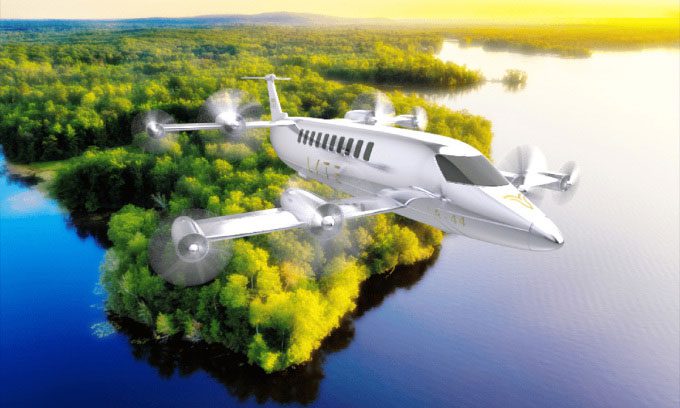The SkyBus, a vertical take-off and landing (VTOL) aircraft, can carry 44 passengers and operate on standard routes like a bus.
Unlike the compact vertical take-off and landing (VTOL) aircraft commonly seen, the first model from the UK startup Lyte Aviation named SkyBus features 44 seats, a maximum speed of 300 km/h, and an operational range exceeding 1,000 km, according to a report by New Atlas on November 9.

Concept of SkyBus aircraft with a capacity of 44 people. (Image: Lyte Aviation).
The design of the SkyBus resembles elongated business jets or small passenger aircraft but features a pair of parallel wings at the front and rear of the fuselage. Each wing is equipped with a medium-sized rotor on the inside and a smaller rotor on the outside, totaling eight propellers. However, they appear quite small relative to the size of the SkyBus.
For vertical take-off and landing, the wings will rotate to direct the rotors upwards. Once airborne, the wings will tilt forward until cruising speed is reached. This tilting wing concept has been proposed before, but not at such a scale.
The SkyBus will use conventional or sustainable jet fuel to power its turboprop engines. The vehicle’s expected power output will be between 3,500 and 5,000 horsepower.
Lyte aims for the aircraft to utilize a clean electric-hydrogen propulsion system once this technology is proven and widely adopted. The company hopes to build a full-size prototype by 2024 and be ready for flight in 2025. They have also announced a pre-order agreement with Indian company Vman Aviation Services for 10 SkyBus aircraft at a total cost of $428 million.
The uniqueness of the SkyBus lies in its size. It can facilitate numerous regional flights with a range of 1,000 km, offering the advantage of not requiring runways for take-off and landing. It can provide quick and easy flights between islands for 44 passengers, or fly standard routes like a bus in the sky.


















































